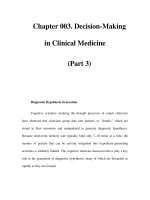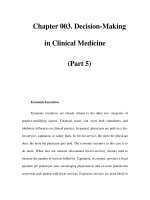Chapter 003. Decision-Making in Clinical Medicine (Part 3) ppt
Bạn đang xem bản rút gọn của tài liệu. Xem và tải ngay bản đầy đủ của tài liệu tại đây (13.48 KB, 5 trang )
Chapter 003. Decision-Making
in Clinical Medicine
(Part 3)
Diagnostic Hypothesis Generation
Cognitive scientists studying the thought processes of expert clinicians
have observed that clinicians group data into packets, or "chunks," which are
stored in their memories and manipulated to generate diagnostic hypotheses.
Because short-term memory can typically hold only 7–10 items at a time, the
number of packets that can be actively integrated into hypothesis-generating
activities is similarly limited. The cognitive shortcuts discussed above play a key
role in the generation of diagnostic hypotheses, many of which are discarded as
rapidly as they are formed.
A diagnostic hypothesis sets a context for diagnostic steps to follow and
provides testable predictions. For example, if the enlarged and quite tender liver
felt on physical examination is due to acute hepatitis (the hypothesis), certain
specific liver function tests should be markedly elevated (the prediction). If the
tests come back normal, the hypothesis may need to be discarded or substantially
modified.
One of the factors that make teaching diagnostic reasoning difficult is that
expert clinicians do not follow a fixed pattern in patient examinations. From the
outset, they are generating, refining, and discarding diagnostic hypotheses. The
questions they ask in the history are driven by the hypotheses they are working
with at the moment. Even the physical examination is driven by specific questions
rather than a preordained checklist. While the student is palpating the abdomen of
the alcoholic patient, waiting for a finding to strike him, the expert clinician is on a
focused search mission. Is the spleen enlarged? How big is the liver? Is it tender?
Are there any palpable masses or nodules? Each question focuses the attention of
the examiner to the exclusion of all other inputs until answered, allowing the
examiner to move on to the next specific question.
Negative findings are often as important as positive ones in establishing
and refining diagnostic hypotheses. Chest discomfort that is not provoked or
worsened by exertion in an active patient reduces the likelihood that chronic
ischemic heart disease is the underlying cause. The absence of a resting
tachycardia and thyroid gland enlargement reduces the likelihood of
hyperthyroidism in a patient with paroxysmal atrial fibrillation.
The acuity of a patient's illness can play an important role in overriding
considerations of prevalence and other issues described above. For example,
clinicians are taught to consider aortic dissection routinely as a possible cause of
acute severe chest discomfort along with myocardial infarction, even though the
typical history of dissection is different from myocardial infarction and dissection
is far less prevalent (Chap. 242). This recommendation is based on the recognition
that a relatively rare but catastrophic diagnosis like aortic dissection is very
difficult to make unless it is explicitly considered. If the clinician fails to elicit any
of the characteristic features of dissection by history and finds equivalent blood
pressures in both arms and no pulse deficits, he or she may feel comfortable in
discarding the aortic dissection hypothesis. If, however, the chest x-ray shows a
widened mediastinum, the hypothesis may be reinstated and a diagnostic test
ordered [e.g., thoracic computed tomography (CT) scan, transesophageal
echocardiogram] to evaluate it more fully. In nonacute situations, the prevalence
of potential alternative diagnoses should play a much more prominent role in
diagnostic hypothesis generation.
Generation of Diagnostic Hypotheses
Because the generation and evaluation of appropriate diagnostic hypotheses
is a skill that not all clinicians possess to an equal degree, errors in this process can
occur; in the patient with serious acute illness, these may lead to tragic
consequences. Consider the following hypothetical example. A 45-year-old male
patient with a 3-week history of a "flulike" upper respiratory infection (URI)
presented to his physician with symptoms of dyspnea and a productive cough.
Based on the presenting complaint, the clinician pulled out a "URI Assessment
Form" to improve quality and efficiency of care. The physician quickly completed
the examination components outlined on this structured form, noting in particular
the absence of fever and a clear chest examination. He then prescribed an
antibiotic for presumed bronchitis, showed the patient how to breathe into a paper
bag to relieve his "hyperventilation," and sent him home with the reassurance that
his illness was not serious. After a sleepless night with significant dyspnea
unrelieved by breathing into a bag, the patient developed nausea and vomiting and
collapsed. He was brought into the Emergency Department in cardiac arrest and
could not be resuscitated. Autopsy showed a posterior wall myocardial infarction
and a fresh thrombus in an atherosclerotic right coronary artery. What went
wrong? The clinician decided, even before starting the history, that the patient's
complaints were not serious. He therefore felt confident that he could perform an
abbreviated and focused examination using the URI assessment protocol rather
than considering the full range of possibilities and performing appropriate tests to
confirm or refute his initial hypotheses. In particular, by concentrating on the
"URI," the clinician failed to elicit the full dyspnea history, which would have
suggested a far more serious disorder, and neglected to search for other symptoms
that could have directed him to the correct diagnosis.
This example illustrates how patients can diverge from textbook symptoms
and the potential consequences of being unable to adapt the diagnostic process to
real-world challenges. The expert, while recognizing that common things occur
commonly, approaches each evaluation on high alert for clues that the initial
diagnosis may be wrong. Patients often provide information that "does not fit"
with any of the leading diagnostic hypotheses being considered. Distinguishing
real clues from false trails can only be achieved by practice and experience. A
less-experienced clinician who tries to be too efficient (as in the above example)
can make serious errors. Use of a rapid systematic clinical survey of symptoms
and organ systems can help prevent the clinician from overlooking important but
inapparent clues.









